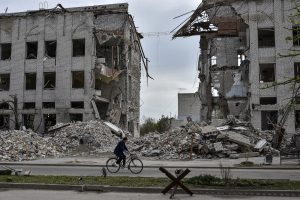A Russian foreign policy expert, Fyodor Lukyanov, stated the other day in Beijing that World War III has already begun. He argued that instead of one global conflict that would quickly escalate toward nuclear war, this world war is being fought in the form of a chain of regional conflicts. He may have a point.
From the war in Ukraine, to the war in Gaza, to tensions in the South China Sea, the Taiwan Strait, and the Korean Peninsula, regional conflicts have involved all the great powers, either as combatants or in proxy roles. Except for Russia’s invasion of Ukraine and Israel’s ghastly war in Gaza, the other regional hotspots have yet to erupt as full-blown conflicts; if they do, the two largest superpowers, China and the United States, could be at war.
The bad news is that these conflicts are escalating in the face of futile efforts to mediate. After a feeble Ukrainian counteroffensive over the summer, Russia is now on the offensive in Ukraine. Kyiv’s valiant resistance could lose vital support from the U.S., which is tiring of the war. Meanwhile, China is providing more help to Russia, which is exacerbating already threadbare China-U.S. relations. In the South China Sea and close to the Taiwan Strait, the navies of China and the United States are sailing ever closer to confrontation.
Meanwhile, Israel’s assault on Gaza continues to kill and maim the people of the besieged territory and the Middle East is on the brink of a wider war. Israel’s attack on an Iranian consulate in Syria led for the first-time led to direct retaliation from Tehran. Israel responded with a missile attack on Iran that could now see much greater escalation in the region.
In Africa, the situation is no better. Festering conflicts exacerbated by climate change and resulting displacement fuel a pipeline of humans seeking refuge in Europe, which is tearing apart societies in both continents. Federal arrangements across a wide range of complex societies such as Ethiopia, Somalia, and Sudan have all but collapsed and fuel vicious incipient or actual civil wars.
Much as during the last world war, Latin America serves as a bystander, sometimes taking sides, but otherwise marching to its own regional dynamic, which is fragile but generally pacific. One has to go back to the mid-1990s to recall an incident of inter-state warfare in the Americas.
The new edition of war deploys weapons such as drones and unmanned surface vessels that are re-writing the rules of warfare – for the first time, once-insurmountable commanding positions are subject to precise targeting at little cost. Fortunately, this more effective, targeted warfare, while it more precisely kills civilians using AI algorithms, makes it less likely that weapons of mass destruction will be needed.
The last world war was fought over visions of empire and resistance to imperial tyranny. This 21st century edition of world war is less about principles and more about interests.
Yet like World War II, alliances have evolved that define battle lines: NATO in Europe, Iran’s Axis of Resistance in the Middle East, AUKUS and the Quad in East Asia. The growing strength of these alliances is in itself a conflict risk, as members are increasingly obliged to defend each other. The United States is actively promoting a new NATO-like alliance in Asia that would see Australia, Japan, South Korea, and the U.S. allied against China’s rising power.
China has countered with what it calls the General Security Initiative that promises “balanced, effective and sustainable security architecture.” It is strong on broad principles such as respect for sovereignty and equality, but is weak on operational detail. China’s global diplomatic footprint, although lengthening, remains tentative and risk averse.
Ending World War II was all about the eventual military supremacy of one alliance over another – and let’s not forget a weapon of mass destruction, the first atom bomb, was the deciding factor in Japan’s capitulation. There were also a series of major conferences, from Cairo and Yalta to San Francisco and Potsdam, with agreements that ensued to help protect global security in the post war era. These arrangements seemed to have run their course by the third decade of the 21st century.
Will World War III end the same way? Will there be a reframing of global security guaranteed by a set of laws and supporting institutions? Perhaps not. The Western-led “rules-based order” that emerged after 1945 is increasingly challenged by an array of emerging middle powers and a web of interests that is not wedded to a specific set of norms and values.
Worse still, adherence to these norms and values is eroding fast as the U.S. and Europe grapple with conflicting interests and the rising costs of sustaining their own societies. Identity and culture wars are tearing at the fabric of old-fashioned Western values.
Perhaps then, the post-World War III world be one of perpetual short-term transaction, trading increasingly threatened and scarce resources, and forging smaller impermanent interest groups based on trade and connectivity. Look at the way today’s Gulf states manage to make their way in the world, with fingers in many pies, influence that far outstrips their size, and an allergy to principle. This trade-based rather than rules-based order may well be the future of humanity.

































